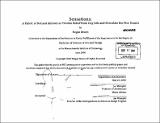Sensations: a fabric of natural alcoves to provide relief from city life and stimulate the five senses
Author(s)
Brown, Megan (Megan Francesca)
DownloadFull printable version (29.45Mb)
Alternative title
Fabric of natural alcoves to provide relief from city life and stimulate the five senses
Other Contributors
Massachusetts Institute of Technology. Dept. of Architecture.
Advisor
Jan Wampler.
Terms of use
Metadata
Show full item recordAbstract
Cities have always been, and will likely always be, hectic. With every new technological advance this characteristic becomes amplified, and today city life offers little relief from cell phone chatter, honking car horns, bustling crowds and towering buildings. This is the essence of the city, and to many can be considered to be part of its charm, but it does not provide opportunities for relaxation and peace, creates an individualized society with little opportunity to form communities and also allows for very little interaction with nature. The goal of my thesis is not to design a way to change the vivacity of the city, but rather to create a fabric within it that would provide temporary escapes into natural environments scattered throughout and inspire a new way of city life. These "natural alcoves" uniquely bring nature into the city and are designed to stimulate the five senses: sight, smell, taste, touch and sound. They are connected both by design similarities and shared materiality, and create unique paths between them that run through the city and further insert nature into its environment. I have designed five possible alcoves for Davis Sq., in Somerville. These are not intended to exist independently, but rather to be part of the much larger fabric with even more diverse spaces utilizing similar characteristics, and together could be used as a prototype for other similar surroundings. Olmstead designed Boston's Emerald Necklace in order to provide all city residents with a relief from the pollution, noise and overcrowding of city life. In doing so, he created a network of parks throughout the city that united the greater Boston area through nature. As life becomes progressively more hectic, the need for relief from city life becomes increasingly necessary. We currently have the opportunity to follow Olmstead's lead and produce a framework of places that are compatible with the electronic age but also give a break from frenzied city life.
Description
Thesis (S.B. in Art and Design)--Massachusetts Institute of Technology, Dept. of Architecture, 2008. Cataloged from PDF version of thesis. Includes bibliographical references (p. 91).
Date issued
2008Department
Massachusetts Institute of Technology. Department of ArchitecturePublisher
Massachusetts Institute of Technology
Keywords
Architecture.